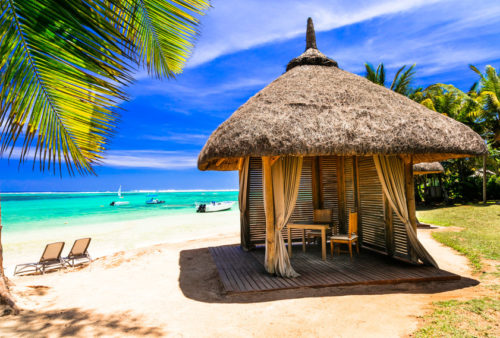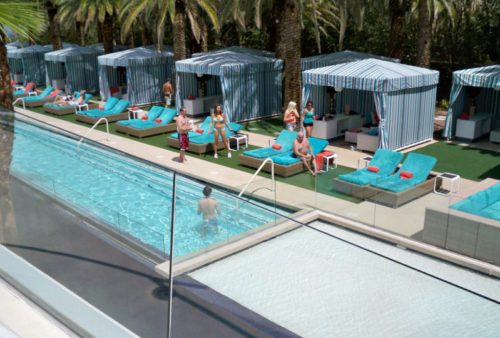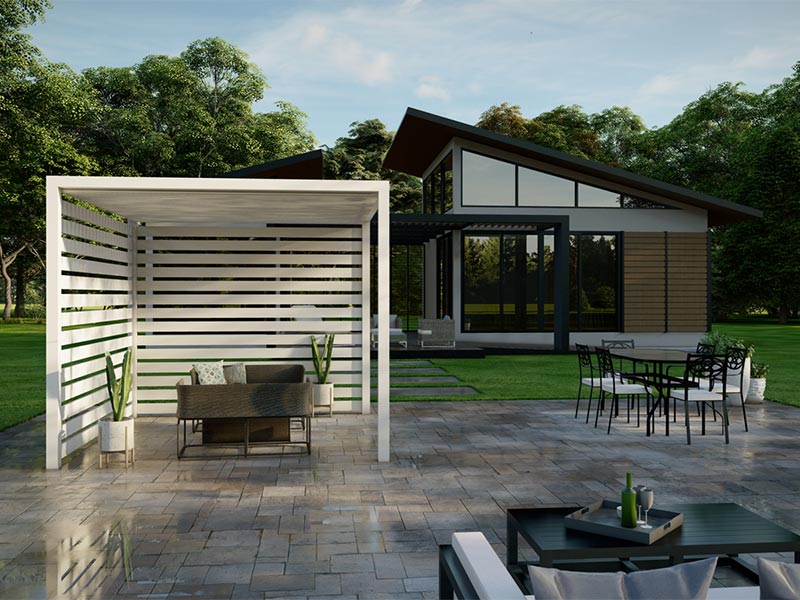Just ask someone to imagine a cabana and their mind will immediately leap to sheer relaxation. For some, envisioning a cabana may evoke a rustic thatched hut standing alone on an endless beach. Others may conjure a well-appointed pool-side hideaway at a luxury resort. Over its centuries of evolution, the cabana has always been connected with revitalizing refreshment and enjoyment. From its early days as mere changing room for Romans enjoying communal bath houses to the modern-day patio cabana seen in backyards and pool decks throughout America, the cabana holds a mood-altering appeal.
Table of Contents
What is a Cabana?
At its most elemental, a cabana is a free-standing structure intended to provide privacy and shade. Cabanas usually feature a roof and three walls, with an open front that faces the pool or beach. The structure can often be seen with a sturdy fixed roof, though flexible cloth or canvas roofs are popular among the luxury resorts of Las Vegas and Miami Beach. At the beach or pool resort, cabanas can be reserved for the day to provide guests a private space to change or shut off from the crowds. Cabanas have also become a popular addition for homeowners looking to bring this resort-style luxury to their own outdoor living spaces.
History of the Cabana
The earliest cabanas date back to the Roman Empire. Before the advent of modern plumbing, Romans of ever social class frequented communal bath houses. For the well-off Romans the bath houses were often well-appointed with gilding and marble throughout. Roman engineers even devised methods to heat the water and the small private changing rooms off the large communal baths. As bathing became a more private activity performed in the home, the convivial social aspects of the baths became less about personal hygiene and more about relaxing and socializing. The cabana evolved from a simple changing room to a shaded relaxation space to spend the day poolside.
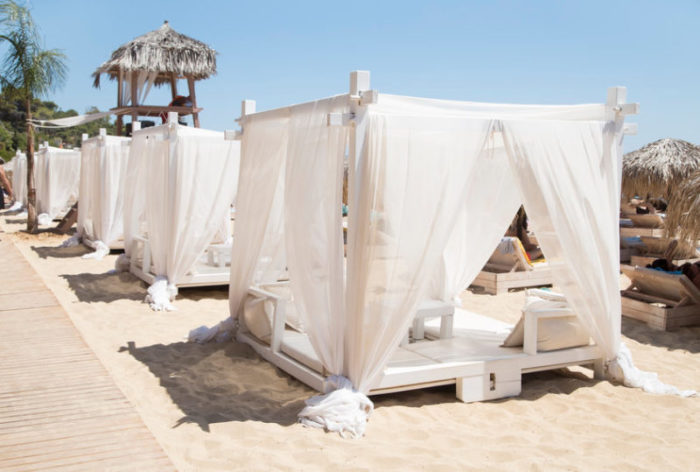
In the US, cabanas are often associated with luxury resorts or refined beach-front relaxation. For homeowners looking to bring that luxury feel to their own homes, cabanas have become a serene addition to a patio, deck, garden or pool deck. Simple DIY cabana kits can offer basic shade over a daybed, but many homeowners are choosing sturdier structures that can withstand the elements and make their cabana into an all-weather relaxation destination. Modern cabanas often feature modular, fully-customizable structures that can fit in alongside any home’s architectural style and adjust to the homeowner’s desired use of the space.
Modern Aluminum Cabana and Design
The great flexibility of modern cabanas is due in large part to the materials with which the structures are built. Traditionally, cabanas have been fabricated from wood. More and more, homeowners are turning to more durable materials such as lightweight vinyl, or for a truly life-long structure, aluminum. An aluminum cabana, properly powder coated, not only makes for an aesthetically appealing look, but ensures the cabana will stand up to brutal coastal weather, even snow and ice. These modern materials also enable extensive engineering flexibility.
The Azenco K-BANA™, for example, leverages its aluminum construction to eliminate the need for traditional footings or a foundation. It relies on its unique self-leveling post bases to adjust to uneven ground. Without the need for footings, the K-BANA™ often requires no building permit, helping homeowners streamline their cabana installation. Beyond their structural advantages, the adoption of these modern materials also allows flexibility in how homeowners use their cabanas, how they can be customized to fit into today’s modern architecture, and the intuitive features that can be embedded in the structure.
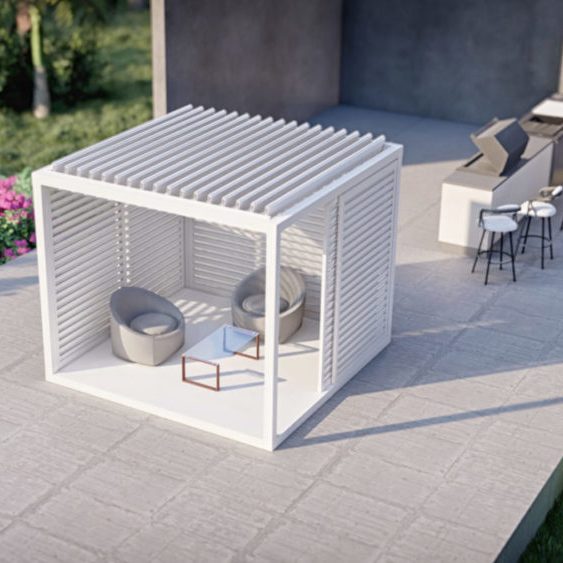
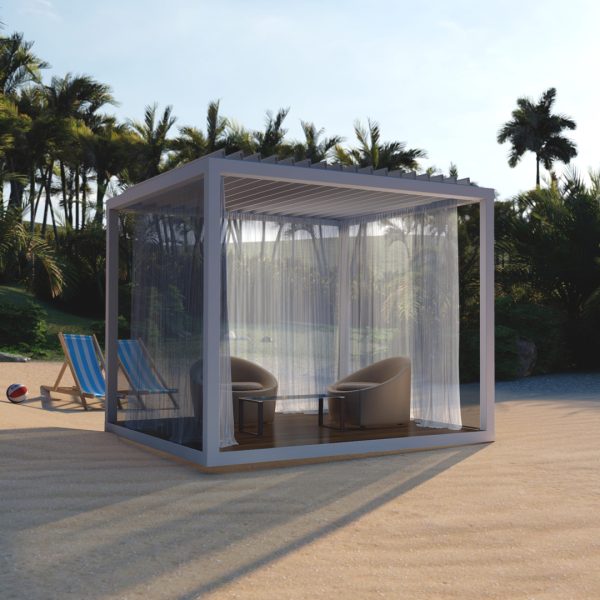
Modern Aluminum Cabana Benefits
Modern aluminum cabanas offer several benefits, making them a popular choice for outdoor spaces. Here are some key advantages:
- Durability and Longevity: Aluminum is known for its strength and resistance to corrosion and rust. This makes aluminum cabanas exceptionally durable, even in harsh weather conditions like rain, wind, and sunlight exposure.
- Low Maintenance: Unlike wood or other materials that may require regular treatment, painting, or sealing, aluminum cabanas need minimal maintenance. They typically only need occasional cleaning to keep them looking new.
- Lightweight and Easy to Install: Aluminum is a lightweight material, which makes the installation of aluminum cabanas relatively easy. This can be particularly beneficial for temporary setups or where mobility is desired.
- Modern Aesthetic: Aluminum cabanas often have a sleek, modern design. They can add a contemporary touch to any outdoor setting, whether it’s a residential garden, a beach, or a poolside area.
- Eco-Friendly: Aluminum is a recyclable material. Choosing an aluminum cabana can be a more environmentally friendly option compared to some other materials.
- Thermal Conductivity: While this can be a downside in hot climates due to heat absorption, it can be mitigated with coatings or design features like mobile louvers, making these cabanas adaptable to various climates.
- Cost-Effectiveness: In the long run, the durability and low maintenance of aluminum can make it a cost-effective choice, even if the initial investment is higher than some other materials.
Luxury Aluminum Cabana
While a traditional cabana can still serve its original purpose as a mild-mannered changing room, an aluminum cabana can be customized to bring the Zen of a luxurious getaway to any backyard. Modern pergolas are often fully-modular designs, allowing homeowners to mix and match paneled segments to create unique shaped and sized outdoor living spaces. This modular design allows the cabana to easily scale from cozy pool-side respite to expansive outdoor dining room. Other modern features which can be easily incorporated into a modular freestanding cabana design include:
- Telescopic sliding walls fitted with fixed or adjustable louvers to maintain airflow while ensuring privacy
- Motorized louvered roof panels can open and close at the touch of a button and seal out the rain
- Integrated drainage hides the downspouts inside the aluminum frame for a clean exterior look while shipping water away from the cabana’s living space
- Integrated screens can guarantee privacy and shade while adding a décor accent to tie the space together
- Intuitive features like embedded power outlets, infrared heaters, etc. bring true all-weather livability to the cabana
- Customized flooring can be uniquely matched to the surrounding design aesthetic to coordinate with composite or wood decking, tile or even panels of manicured grass that seamlessly blend with a surrounding lawn
The cabana has come a long way since its genesis alongside the Roman baths. Its unique ability to relax the mind, body, and soul has long made the cabana a favorite vacation respite. With the advent of modern cabana materials unlocking some truly unique design possibilities, homeowners can now bring this luxurious resort amenity to their own patio cabana.


